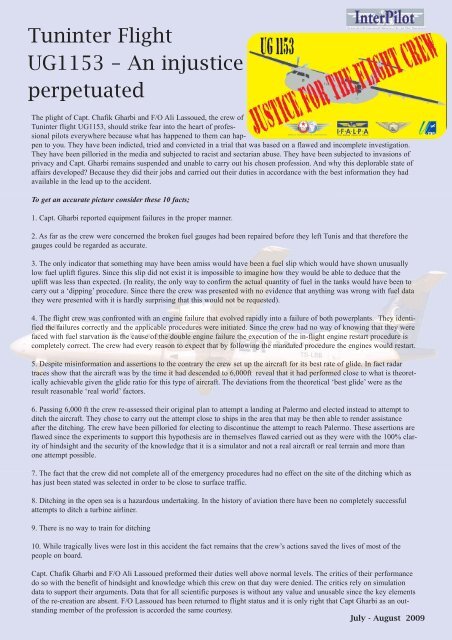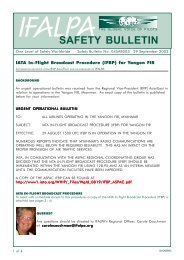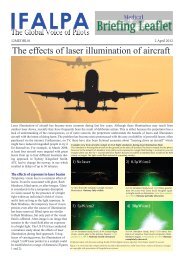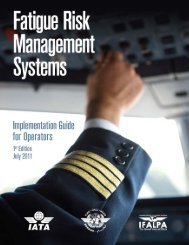Create successful ePaper yourself
Turn your PDF publications into a flip-book with our unique Google optimized e-Paper software.
Tuninter Flight<br />
UG1153 – An injustice<br />
perpetuated<br />
The plight of Capt. Chafik Gharbi and F/O Ali Lassoued, the crew of<br />
Tuninter flight UG1153, should strike fear into the heart of professional<br />
pilots everywhere because what has happened to them can happen<br />
to you. They have been indicted, tried and convicted in a trial that was based on a flawed and incomplete investigation.<br />
They have been pilloried in the media and subjected to racist and sectarian abuse. They have been subjected to invasions of<br />
privacy and Capt. Gharbi remains suspended and unable to carry out his chosen profession. And why this deplorable state of<br />
affairs developed? Because they did their jobs and carried out their duties in accordance with the best in<strong>for</strong>mation they had<br />
available in the lead up to the accident.<br />
To get an accurate picture consider these 10 facts;<br />
1. Capt. Gharbi reported equipment failures in the proper manner.<br />
2. As far as the crew were concerned the broken fuel gauges had been repaired be<strong>for</strong>e they left Tunis and that there<strong>for</strong>e the<br />
gauges could be regarded as accurate.<br />
3. The only indicator that something may have been amiss would have been a fuel slip which would have shown unusually<br />
low fuel uplift figures. Since this slip did not exist it is impossible to imagine how they would be able to deduce that the<br />
uplift was less than expected. (In reality, the only way to confirm the actual quantity of fuel in the tanks would have been to<br />
carry out a ‘dipping’ procedure. Since there the crew was presented with no evidence that anything was wrong with fuel data<br />
they were presented with it is hardly surprising that this would not be requested).<br />
4. The flight crew was confronted with an engine failure that evolved rapidly into a failure of both powerplants. They identified<br />
the failures correctly and the applicable procedures were initiated. Since the crew had no way of knowing that they were<br />
faced with fuel starvation as the cause of the double engine failure the execution of the in-flight engine restart procedure is<br />
completely correct. The crew had every reason to expect that by following the mandated procedure the engines would restart.<br />
5. Despite misin<strong>for</strong>mation and assertions to the contrary the crew set up the aircraft <strong>for</strong> its best rate of glide. In fact radar<br />
traces show that the aircraft was by the time it had descended to 6,000ft reveal that it had per<strong>for</strong>med close to what is theoretically<br />
achievable given the glide ratio <strong>for</strong> this type of aircraft. The deviations from the theoretical ‘best glide’ were as the<br />
result reasonable ‘real world’ factors.<br />
6. Passing 6,000 ft the crew re-assessed their original plan to attempt a landing at Palermo and elected instead to attempt to<br />
ditch the aircraft. They chose to carry out the attempt close to ships in the area that may be then able to render assistance<br />
after the ditching. The crew have been pilloried <strong>for</strong> electing to discontinue the attempt to reach Palermo. These assertions are<br />
flawed since the experiments to support this hypothesis are in themselves flawed carried out as they were with the 100% clarity<br />
of hindsight and the security of the knowledge that it is a simulator and not a real aircraft or real terrain and more than<br />
one attempt possible.<br />
7. The fact that the crew did not complete all of the emergency procedures had no effect on the site of the ditching which as<br />
has just been stated was selected in order to be close to surface traffic.<br />
8. Ditching in the open sea is a hazardous undertaking. In the history of aviation there have been no completely successful<br />
attempts to ditch a turbine airliner.<br />
9. There is no way to train <strong>for</strong> ditching<br />
10. While tragically lives were lost in this accident the fact remains that the crew’s actions saved the lives of most of the<br />
people on board.<br />
Capt. Chafik Gharbi and F/O Ali Lassoued pre<strong>for</strong>med their duties well above normal levels. The critics of their per<strong>for</strong>mance<br />
do so with the benefit of hindsight and knowledge which this crew on that day were denied. The critics rely on simulation<br />
data to support their arguments. Data that <strong>for</strong> all scientific purposes is without any value and unusable since the key elements<br />
of the re-creation are absent. F/O Lassoued has been returned to flight status and it is only right that Capt Gharbi as an outstanding<br />
member of the profession is accorded the same courtesy.<br />
July - August 2009





